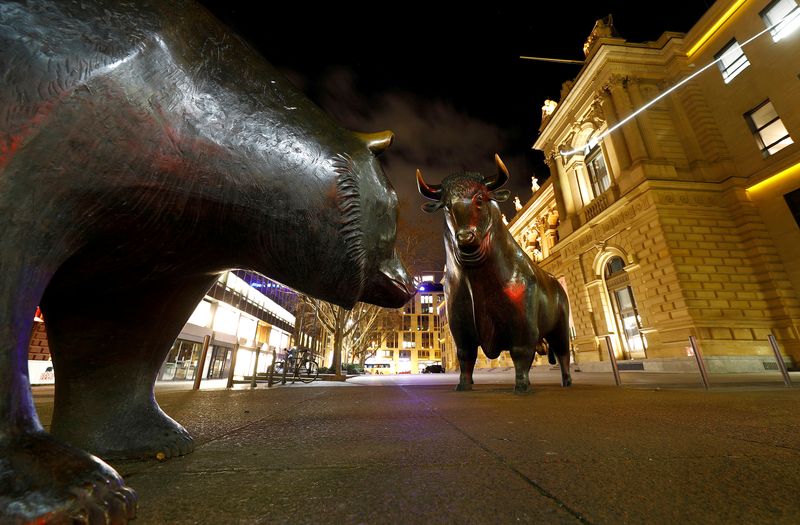By Jamie McGeever
ORLANDO, Fla. (Reuters) -When Yogi Berra famously said it's difficult to make forecasts, especially about the future, he probably didn't have financial market analysts in mind.
But the celebrated baseball player's famous malapropism, also expressed in similar ways by others, probably applies as much to predicting the outlook for stocks, bonds and currencies as anything else, as the tumultuous events of 2022 underscored.
Wall Street analysts are notoriously optimistic. Some might say it's because of the investment banking fees their employers receive from the S&P 500's constituent companies, and because being bullish is better for drumming up business.
Also, stock markets usually go up, so down years are by definition surprises. However, this is precisely where clients might reasonably expect their well-remunerated investment bank and fund management experts to earn their corn.
Crashes are hard to time, but they often follow a slow build-up of financial imbalances, rising interest rates or specific triggers: the Great Depression, the 1970s oil shocks, the dotcom bust, Lehman.
Some of the biggest crashes on record - Black Monday in October 1987, or the pandemic plunge of March 2020 - don't even register on the annual scorecard and are ultimately subsumed in 'up' years. Equity investors' powers of recovery are strong.
So is their optimism, which may explain why analysts almost always predict the year ahead will be a good one. This year was no exception.
A Reuters poll of 45 analysts on Dec. 1, 2021, showed that the median end-2022 forecast for the S&P 500 was 4910 points which, which at the time of publication translated into a rise of 7.5%.
The median earnings growth forecast was just under 8%.
Right now the S&P 500 is below 4000, down 17% year to date and on course for one of its biggest falls in 80 years. Fourth- quarter earnings growth is projected to be negative.
Granted, hardly anybody foresaw Russia's invasion of Ukraine in February, the unleashed chaos in commodity and energy markets, and the burst of global inflation. That obviously dealt a huge blow to stocks and risk assets.
But price pressures were already a clear and present danger this time last year - global supply chains were clogged up, and Fed Chair Jerome Powell and Treasury Secretary Janet Yellen said within days of each other that inflation was no longer 'transitory'.
Even after Russia's Feb. 24 invasion of Ukraine brought war to Europe's doorstep, Wall Street's confidence - some might say hubris - was alive and well. A Reuters poll in late May showed that the median end-2022 forecast for the S&P 500 was 4400 points, reflecting a gain of 11.7% at the time.
STILL OPTIMISTIC
Such is the nature of the macro and market forecasting game, if you're going to get it wrong you'd better hope enough of your peers do too. It's safe to say this is what happened this year.
Deutsche Bank (ETR:DBKGn)'s Jim Reid on Wednesday noted that just 19% of the 750 respondents - mostly clients - in the bank's year-end 2021 survey thought the S&P 500 would post a negative return this year, and only 3% predicted a decline of more than 15%.
That was despite the fact that respondents correctly said the two biggest risks for 2022 were "higher-than-expected inflation" and "an aggressive Fed tightening cycle".
But even then, hardly anyone quite predicted how powerful inflation and the Fed's response would be - just 2% of respondents thought U.S. consumer price inflation would be above 7% by the end of this year, and the median rate hike estimate was for 50 basis points.
Their U.S. bond market forecasts were even more off-beam - only 2% of respondents predicted the 10-year Treasury yield would end this year above 3.0% and just four individuals thought it would be above 3.5%. It is currently 3.48%.
"If you were any of those four people out of 750 please email me to tell me your predictions for the next 12 months," Reid quipped in a note on Wednesday.
No one knows what 2023 holds but the general outlook for Wall Street is once again pretty bright. A Reuters poll of 41 strategists published on Nov. 29 showed that the S&P 500 will end next year at 4200, up 6.8% from Wednesday's close.
Analysts at Citi, however, reckon the consensus is far too optimistic, with current U.S. stock market pricing implying earnings growth next year of around 4%.
They say an earnings recession is coming, and point out that the average fall in earnings during previous downturns over the past half century is 28%. Bulls beware.
(The opinions expressed here are those of the author, a columnist for Reuters.)
Related columns:

- 2023 market predictions - when the outrageous and plausible blur
- Dodging recession could whiplash markets
(By Jamie McGeever; Editing by Andrea Ricci)